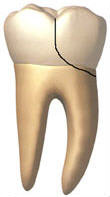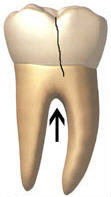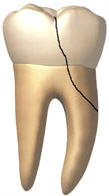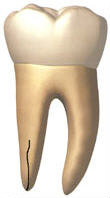Fractured Teeth
Fractured Cusp
 This is the most common type of tooth fracture and has the best long term prognosis. In this type of fracture, a part of the tooth can completely break off and, occasionally, no pain is felt after the tooth fractures.
This is the most common type of tooth fracture and has the best long term prognosis. In this type of fracture, a part of the tooth can completely break off and, occasionally, no pain is felt after the tooth fractures.
Treatment for this type of fracture is to place a crown on the tooth. If the fracture extends into the middle part of the tooth, root canal therapy would be required in addition to a crown.
Vertical Furcation Fracture
 This tooth has a vertical crack that extends vertically into or toward the furcation. The furcation, which is where the arrow is pointing, is the place where the tooth splits into two or more separate roots. The nerve is almost always involved in a vertical furcation crack. The tooth rarely separates into two pieces because the tooth is held in position by the surrounding bone.
This tooth has a vertical crack that extends vertically into or toward the furcation. The furcation, which is where the arrow is pointing, is the place where the tooth splits into two or more separate roots. The nerve is almost always involved in a vertical furcation crack. The tooth rarely separates into two pieces because the tooth is held in position by the surrounding bone.
The prognosis for this type of crack is fair but it depends on how deep the crack extends into the internal aspect of the tooth. The options are to treat the tooth with a root canal followed by a build up, post and crown or to extract the tooth.
Split Root Fracture
 A split root fracture, also known as a subgingival oblique fracture, can be restorable depending upon where the fracture ends. The term subgingival means below the gumline. If the fracture is not too far below the gumline, the tooth can be restored with a procedure called crown lengthening, followed by adding a crown. The tooth may also require root canal treatment. If the fracture is too far below the gumline, it is unrestorable and requires extraction.
A split root fracture, also known as a subgingival oblique fracture, can be restorable depending upon where the fracture ends. The term subgingival means below the gumline. If the fracture is not too far below the gumline, the tooth can be restored with a procedure called crown lengthening, followed by adding a crown. The tooth may also require root canal treatment. If the fracture is too far below the gumline, it is unrestorable and requires extraction.
These types of fractures occur for various reasons, such as biting down on very hard foods or foreign objects, the presence of a previous filling in the tooth, or a tooth that had root canal therapy that was not treated with a crown.
Vertical Root Fracture
 Vertical root fractures are not a very common type of fracture and usually occur in teeth that have had root canal therapy. If the fracture is very short in length, the tooth may be saved by performing an apicoectomy. This involves gaining access to the root tip within the bone and removing the part of the root that is fractured. The only other option is an extraction.
Vertical root fractures are not a very common type of fracture and usually occur in teeth that have had root canal therapy. If the fracture is very short in length, the tooth may be saved by performing an apicoectomy. This involves gaining access to the root tip within the bone and removing the part of the root that is fractured. The only other option is an extraction.
Oblique Root Fractures
 Oblique Root Fractures are fractures that are limited to the roots of teeth with the crown portion intact. The fractured root is generally entirely below the gumline and usually completely within the bone.
Oblique Root Fractures are fractures that are limited to the roots of teeth with the crown portion intact. The fractured root is generally entirely below the gumline and usually completely within the bone.
If the fracture is close to the crown as shown by number 1 in the diagram to the right, the tooth is usually unrestorable. The tooth might be able to be treated with endodontic therapy and root amputation if the remaining roots are strong and healthy, but the overall prognosis is poor.
If the fracture is close to the tip of the root as shown by number 2 in the diagram, the tooth may be restored with root canal therapy. A root canal cannot be performed on a fractured root tip and the body tends to resorb the untreated piece. The prognosis for this procedure is fair to good, and regular exams are recommended to check how the body responds to the treatment.


